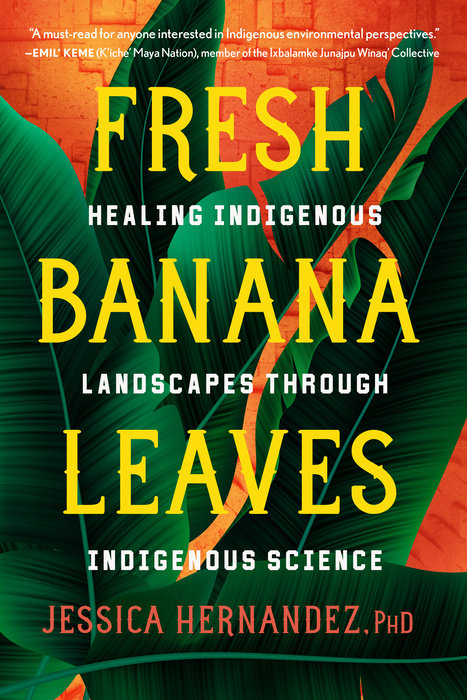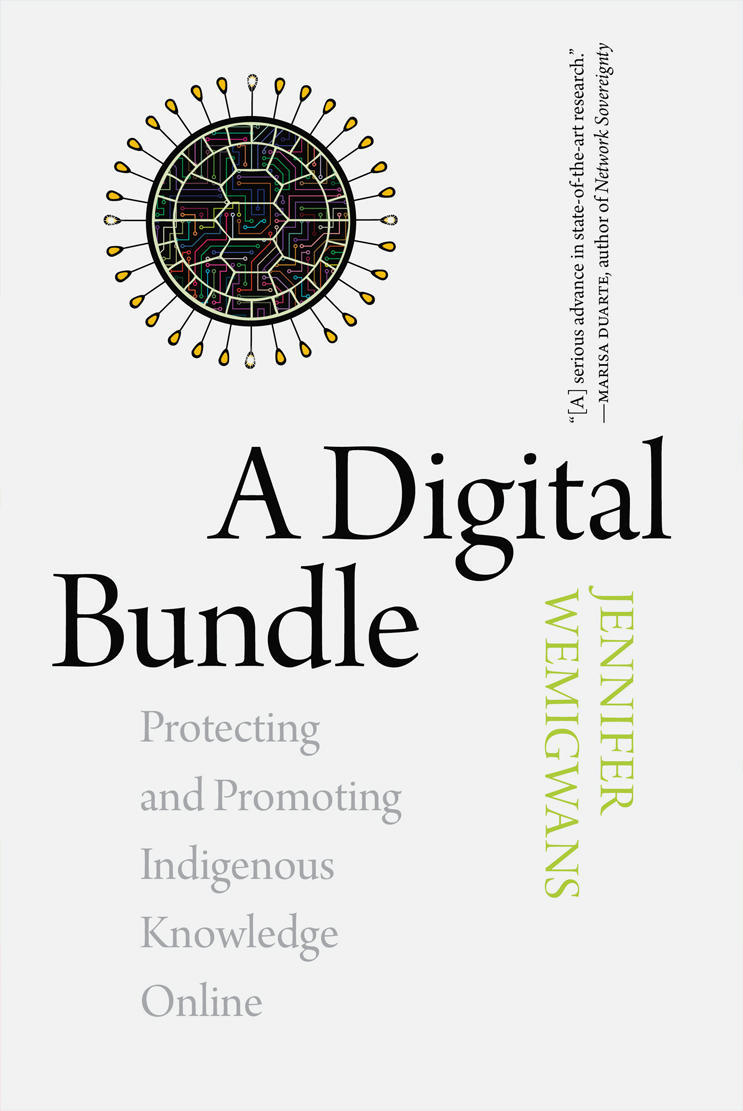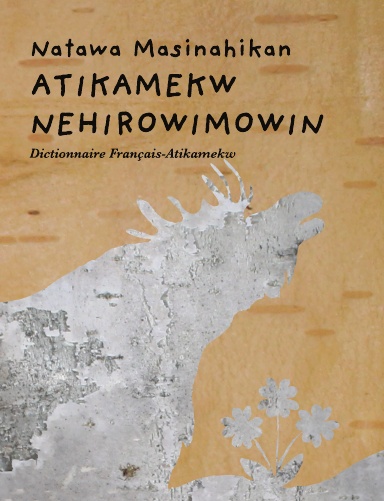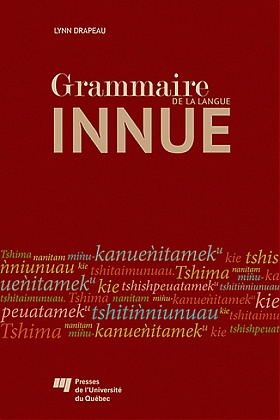- PRÊTS ET ACCÈS
- RECHERCHE
- SERVICES
- ESPACES
- RESSOURCES
- À PROPOS
- NOUS JOINDRE
PRÊT ET ACCÈS
RECHERCHE
ESPACES
RESSOURCES

« An Indigenous environmental scientist breaks down why western conservationism isn’t working–and offers Indigenous models informed by case studies, personal stories, and family histories that center the voices of Latin American women and land protectors. Despite the undeniable fact that Indigenous communities are among the most affected by climate devastation, Indigenous science is nowhere to be found in mainstream environmental policy or discourse. And while holistic land, water, and forest management practices born from millennia of Indigenous knowledge systems have much to teach all of us, Indigenous science has long been ignored, otherized, or perceived as “soft”–the product of a systematic, centuries-long campaign of racism, colonialism, extractive capitalism, and delegitimization.
Here, Jessica Hernandez–Maya Ch’orti’ and Zapotec environmental scientist and founder of environmental agency Piña Soul–introduces and contextualizes Indigenous environmental knowledge and proposes a vision of land stewardship that heals rather than displaces, that generates rather than destroys. She breaks down the failures of western-defined conservatism and shares alternatives, citing the restoration work of urban Indigenous people in Seattle; her family’s fight against ecoterrorism in Latin America; and holistic land management approaches of Indigenous groups across the continent.
Through case studies, historical overviews, and stories that center the voices and lived experiences of Indigenous Latin American women and land protectors, Hernandez makes the case that if we’re to recover the health of our planet–for everyone–we need to stop the eco-colonialism ravaging Indigenous lands and restore our relationship with Earth to one of harmony and respect. »
(North Atlantic Books)

A New York Times Bestseller
A Washington Post Bestseller
A Los Angeles Times Bestseller Named a “Best Essay Collection of the Decade” by Literary Hub
A Washington Post “2020 Holiday Gift Guide” Recommendation
A Book Riot “Favorite Summer Read of 2020”
A Food Tank Reading Recommendation for Fall 2020
“I give daily thanks for Robin Wall Kimmerer for being a font of endless knowledge, both mental and spiritual.” —RICHARD POWERS, NEW YORK TIMES
Updated with a new introduction from Robin Wall Kimmerer, the hardcover special edition of Braiding Sweetgrass, reissued in honor of the fortieth anniversary of Milkweed Editions, celebrates the book as an object of meaning that will last the ages. Beautifully bound with a new cover featuring an engraving by Tony Drehfal, this edition includes a bookmark ribbon, a deckled edge, and five brilliantly colored illustrations by artist Nate Christopherson. In increasingly dark times, we honor the experience that more than 350,000 readers in North America have cherished about the book—gentle, simple, tactile, beautiful, even sacred—and offer an edition that will inspire readers to gift it again and again, spreading the word about scientific knowledge, indigenous wisdom, and the teachings of plants.
As a botanist, Robin Wall Kimmerer has been trained to ask questions of nature with the tools of science. As a member of the Citizen Potawatomi Nation, she embraces the notion that plants and animals are our oldest teachers. In Braiding Sweetgrass, Kimmerer brings these two lenses of knowledge together to take us on “a journey that is every bit as mythic as it is scientific, as sacred as it is historical, as clever as it is wise” (Elizabeth Gilbert).
Drawing on her life as an indigenous scientist, a mother, and a woman, Kimmerer shows how other living beings—asters and goldenrod, strawberries and squash, salamanders, algae, and sweetgrass—offer us gifts and lessons, even if we’ve forgotten how to hear their voices. In a rich braid of reflections that range from the creation of Turtle Island to the forces that threaten its flourishing today, she circles toward a central argument: that the awakening of a wider ecological consciousness requires the acknowledgment and celebration of our reciprocal relationship with the rest of the living world. For only when we can hear the languages of other beings will we be capable of understanding the generosity of the earth, and learn to give our own gifts in return.
(Milkweed Editions)

With the rise of urban living and the digital age, many North American healers are recognizing that traditional medicinal knowledge must be recorded before being lost with its elders. A Cree Healer and His Medicine Bundle is a historic document, including nearly 200 color photos and maps, in that it is the first in which a native healer has agreed to open his medicine bundle to share in writing his repertoire of herbal medicines and where they are found. Providing information on and photos of medicinal plants and where to harvest them, anthropologist David E. Young and botanist Robert D. Rogers chronicle the life, beliefs, and healing practices of Medicine Man Russell Willier in his native Alberta, Canada. Despite being criticized for sharing his knowledge, Willier later found support in other healers as they began to realize the danger that much of their traditional practices could die out with them.
(North Atlantic Books)

First published in 1991, Traditional Plant Foods of Canadian Indigenous Peoples details the nutritional properties, botanical characteristics and ethnic uses of a wide variety of traditional plant foods used by the Indigenous Peoples of Canada. Comprehensive and detailed, this volume explores both the technical use of plants and their cultural connections. It will be of interest to scholars from a variety of backgrounds, including Indigenous Peoples with their specific cultural worldviews; nutritionists and other health professionals who work with Indigenous Peoples and other rural people; other biologists, ethnologists, and organizations that address understanding of the resources of the natural world; and academic audiences from a variety of disciplines.
Table of Contents
1: Introduction;
2: What's so special about Indigenous Foods;
3: An overview of the nutrient value and use of plant foods by Indigenous Peoples;
4: Descriptions and uses of plant foods by Indigenous Peoples;
5: Comprehensive list of plant food species;
6: Nutrient values of traditional plant foods;
Bibliography; Appendices; Index
(Routledge)

An essential contribution to Internet activism and a must read for Indigenous educators, A Digital Bundle frames digital technology as an important tool for self-determination and idea sharing, ultimately contributing to Indigenous resurgence and nation building.
By defining Indigenous Knowledge online in terms of “digital bundles,” Jennifer Wemigwans elevates both cultural protocol and cultural responsibilities, grounds online projects within Indigenous philosophical paradigms, and highlights new possibilities for both the Internet and Indigenous communities.
(University of Regina Press)

In many ways, this book is the first of its kind in the field of Aboriginal language lexicography. Side by side with the talking dictionary Mi'gmaq-Mi'kmaq Online (http://www.mikmaqonline.org/), it is the first Mìgmaq dictionary to be entirely written by a native speaker of the Mìgmaq language with the assistance and guidance of his Mìgmaq Elders, from their own perspective and in their own words. It is also a first of its kind in that it combines the features of a bilingual dictionary with those of a reference dictionary. Instead of providing a reverse word list (English to Mìgmaq) at the end of the volume, our dictionary comes with a stand alone CD-ROM allowing the user to search words both in Mìgmaq and English fields.
(Les Presses de L'Université Laval)

Ce dictionnaire français-atikamekw contient plus de 12 000 mots atikamekw. Il représente la langue parlée dans les trois communautés atikamekw situées en Haute-Mauricie au Québec : Manawan, Opitciwan et Wemotaci.
C’est le premier dictionnaire de langue algonquienne à offrir des définitions dans une langue autochtone. En cela, il est à la fois un dictionnaire unilingue atikamekw et un dictionnaire bilingue français-atikamekw. Il contient une introduction à la langue, de l'information grammaticale, des définitions et des exemples, tirés de textes ou créés par les lexicographes atikamekw pour illustrer le sens des mots.
(Conseil de la Nation Atikamekw)

L'innue, une langue « imagée » à la structure simple et aux moyens réduits? Rien de plus faux! Cette grammaire de référence de la langue innue, inspirée de la basic linguistic theory ou linguistique empirique, déconstruit ce mythe en répertoriant les faits de langue, en les décrivant, en les expliquant et en les reliant entre eux de manière à en élucider la logique. Distingue les dialectes de l'Ouest (parlés à Mashteuiatsh, Pessamit, Uashat et Matimekush) et les dialectes de la Basse Côte-Nord (parlés à Ekuantshit, Nutashkuan, Unaman-shipu et Pakut-shipu).Répertorie les diverses catégories de nominaux : noms, pronoms, démonstratifs et possessifs. Classifie les verbes et expose les conjugaisons, les modalités et les temps verbaux, de même que le système de voix de base et de voix dérivée. Présente les types de propositions et leur articulation et explique les fonctions grammaticales de la phrase. Décrit la formation des mots, soit celle des noms, des adverbes et des verbes.
(Presses de l'Université du Québec)

Première anthologie à paraître en français sur le sujet, Cinéma autochtones : des représentations en mouvements se veut un véritable état des lieux valorisant avant tout les contributions de cinéastes, artistes et chercheur.e.s autochtones du monde entier avec, à leurs côtés, celles de proches collaborateur.trice.s non autochtones. Invitation à s'immerger dans un univers cinématographique créatif et original, ce livre collectif s'affranchit tout autant des frontières chronologiques, géographiques que des genres, afin de mieux célébrer ensemble le pouvoir des créateur.trice.s cinématographiques autochtones d'hier, d'aujourd'hui et de demain.
(L'Harmattan)

Explore the past 150 years through the eyes of Indigenous creators in this groundbreaking graphic novel anthology. Beautifully illustrated, these stories are an emotional and enlightening journey through Indigenous wonderworks, psychic battles, and time travel. See how Indigenous peoples have survived a post-apocalyptic world since Contact.
Each story includes a timeline of related historical events and a personal note from the author. Find cited sources and a select bibliography for further reading in the back of the book. The accompanying teacher guide includes curriculum charts and 12 lesson plans to help educators use the book with their students.
(HighWater Press)

Itee Pootoogook belonged to a new generation of Inuit artists who are transforming and reshaping the creative traditions that were successfully pioneered by their parents and grandparents in the second half of the 20th century.
A meticulous draughtsman who worked with graphite and coloured pencil, Itee depicted buildings in Kinngait that incorporated a perspectival view, a relatively recent practice influenced by his training as a carpenter and his interest in photography. His portraits of acquaintances and family members similarly bear witness to the contemporary North. Whether he depicts them at work or resting, his subjects are engaged in a range of activities from preparing carcasses brought in from hunting to playing music or contemplating the landscape of the North.
Itee was also an inventive landscapist. Many of his finest Arctic scenes emphasize the open horizon that separates land from sky and the ever-shifting colours of the Arctic. Rendering the variable light of the landscape with precision, he brought a level of attention that contributed, over time, to his style.
Featuring more than 100 images and essays by curators, art historians, and contemporary artists, Itee Pootoogook: Hymns to Silence celebrates the creative spirit of an innovative artist. It is the first publication devoted exclusively to his art.
(Goose Lane Editions)
Hungry Listening is the first book to consider listening from both Indigenous and settler colonial perspectives. A critical response to what has been called the “whiteness of sound studies,” Dylan Robinson evaluates how decolonial practices of listening emerge from increasing awareness of our listening positionality. This, he argues, involves identifying habits of settler colonial perception and contending with settler colonialism’s “tin ear” that renders silent the epistemic foundations of Indigenous song as history, law, and medicine.
With case studies on Indigenous participation in classical music, musicals, and popular music, Hungry Listening examines structures of inclusion that reinforce Western musical values. Alongside this inquiry on the unmarked terms of inclusion in performing arts organizations and compositional practice, Hungry Listening offers examples of “doing sovereignty” in Indigenous performance art, museum exhibition, and gatherings that support an Indigenous listening resurgence.
Throughout the book, Robinson shows how decolonial and resurgent forms of listening might be affirmed by writing otherwise about musical experience. Through event scores, dialogic improvisation, and forms of poetic response and refusal, he demands a reorientation toward the act of reading as a way of listening. Indigenous relationships to the life of song are here sustained in writing that finds resonance in the intersubjective experience between listener, sound, and space.
(University of Minnesota Press)
Aide à l'usager
Communiquez avec nous pour de l'aide en ligne aide.bibliotheque@uqat.ca
Accès rapide
La bibliothèque
© Bibliothèque Cégep A-T et UQAT